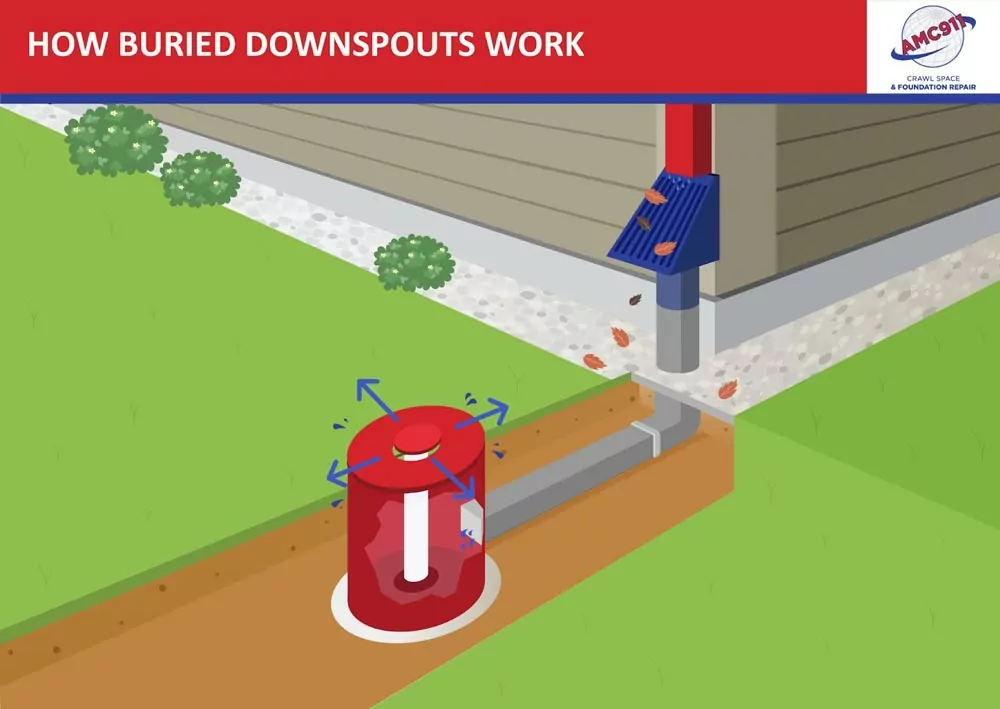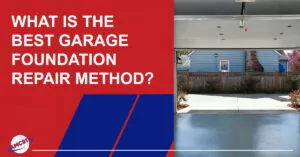There are many items we may have around our homes that we don’t give much thought. They are there for us, day after day, and we expect that they will continue to do their job endlessly.
Downspouts are one of those items that often get overlooked by the homeowner. They come in many shapes and sizes, but buried downspouts are preferred by many because of the benefits they offer.
Like any item in use around the home, there are both benefits and potential problems with buried downspouts. What are the problems–and if you experience them, what can be done to correct them?
What Are Buried Downspouts?
A tremendous amount of water comes off the roof, and the gutter system (including the downspouts) is there to capture the water and control how it goes from the roof to the ground. Buried downspouts are one type of drainage system, but they are designed for a specific purpose.

While many downspouts will control the water runoff from the roof to the ground, they often drain near the foundation. Buried downspouts also control the water as it runs off the roof, but they then carry the water away from the foundation to an area where the water will not impact the home or other structures.
Any area can take advantage of buried downspouts, but they are not frequently used. They tend to be more prevalent in areas with heavy rainfall or storms, as another type of gutter system could be overwhelmed or the drainage may cause damage to the foundation.
Although there are many obvious advantages to using buried downspouts, they aren’t without their problems. In addition, if they aren’t installed correctly, they could lead to drainage issues and property damage in some way or another.
Buried downspouts benefit most homeowners who want to protect their foundation from water damage and have a clean-looking drainage system. Before you decide whether they are right for you, however, it’s best to consider both the pros and cons of having a system like this.
What Are the Pros and Cons of Buried Downspouts?
It is essential to control the rainwater on your property–particularly the runoff from the roof. Buried downspouts provide the opportunity to do that in a unique way by connecting to the gutter system and channeling the water away from the foundation. Below are the benefits and potential problems associated with such a drainage system.
Pros of Buried Downspouts
Aesthetics: Because you are burying the downspout underground, it will not be visible. This adds a considerable amount of curb appeal compared to downspouts that may run on top of the soil.
Protects the foundation: Traditional downspouts drain directly next to the home. That water can cause damage to the foundation–especially in areas of expansive soil. Buried downspouts carry the water away from the foundation to a safer area.
Eliminates standing water: One issue that often goes overlooked by homeowners is the standing water that occurs with traditional downspouts. The standing water can attract insects or become a breeding ground for mosquitoes.
Cons of Buried Downspouts
Clogging: One of the biggest problems with buried downspouts is the possibility of clogging. Since they are underground, any clog would be challenging to clear.
Cleaning: Even if they aren’t clogged, it is still a good idea to clean the downspouts. It keeps the possibility of clogging to a minimum and provides a free water flow away from the home during the storm. Buried downspouts are tougher to clean.
Maintenance: Along with cleaning, other forms of routine maintenance may be necessary from time to time to keep the drainage system running correctly. Buried downspouts can be difficult to maintain.
How Are Buried Downspouts Installed?
Installing a buried downspout may seem like a relatively straightforward project, and many homeowners may even consider trying it on their own–but there is more to it than simply digging a trench and laying a pipe.
The following steps must be taken to properly install the downspout and ensure it will provide benefits for years to come.
1. Location choice: There may be many options for installing a buried downspout, but not all of them will provide the same benefits. Looking at the lay of the land and then installing the downspout so that it drains at least 10 feet away from the foundation toward a downward slope is the best option.
2. Trench: A 12-inch-wide trench must be dug deep enough to bury the downspout to an acceptable level. It must be buried below the freeze line. At a minimum, most buried downspouts will be at least 4 feet deep.
3. Piping system: A perforated drain pipe is installed in the bottom of the trench first to channel excess water from the area and prevent clogging. The downspout is then connected to the drainage pipe and placed into the trench.
4. Backfill: A layer of gravel should be added to the trench, and then the rest of the trench should be backfilled with soil. It should be compacted to keep the soil from settling.
Usually, a buried downspout is directed to a dry well, rain garden, or swale.
How to Prevent Clogs in Buried Downspouts
One of the biggest problems associated with buried downspouts is the possibility of clogging. Debris that comes off of the roof (such as leaves and sticks) can clog the pipe, leading to it overflowing where it connects with the gutter.
While it’s impossible to avoid every clog, there are things you can do to limit the possibility that it will occur. Do the following as part of a routine maintenance program:

1. Proper installation: Although many “weekend warriors” may try to install the buried downspout on their own, it’s a job that is better left to a professional contractor. Any mistakes made in the installation process will likely lead to future clogging.
2. Gutter cleaning: Inspect and clean the gutters regularly. Remove any leaves or other items that may have accumulated in the area. Pay particular attention in the autumn or after a storm that may have blown in debris from nearby trees.
3. Gutter screens: Installing gutter screens or leaf guards can further prevent the possibility of clogging. They stop any debris that runs off the roof from flowing into the downspout.
4. Cleaning and inspecting: The downspout should be inspected regularly to ensure minimal blockages. If blockages are detected, they should be cleared immediately because they will only worsen.
How to Keep Buried Downspouts From Freezing
One potential problem with buried downspouts–especially during the winter months–is the possibility for the line to freeze. This does more than clog the downspout, as it can lead to significant damage to the foundation and the home.
Most of the methods for keeping buried downspouts from freezing involve the installation process. They must be buried below the freeze line and use appropriate materials to stand up to the freeze and thaw cycles associated with the area.
Drainage in the soil around the buried downspout is also important. That is why a perforated pipe is installed at the bottom of the trench and care is given to ensure the area is graded correctly. Otherwise, freezing could occur around the downspout openings.
Cleaning and maintenance of the downspout also helps to prevent freezing. Any clog is a potential area for freezing to likely occur.
Additional options may be available, but they are usually applied during the installation process. These can include wrapping the pipe with insulated material or installing heating cables to keep ice from forming. These are things that should be installed by a professional.
Buried downspouts provide many benefits to the homeowner. There may be problems associated with them on occasion–but most can be overcome with proper installation by a professional and routine maintenance.















